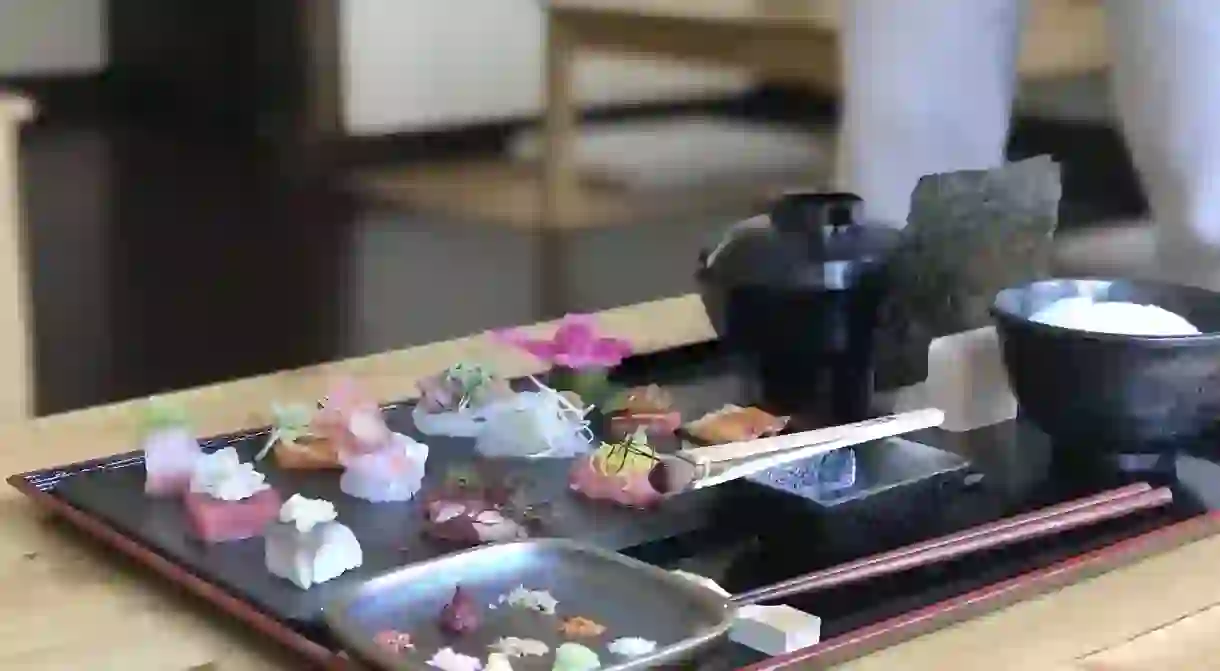At Ume, Playing With Your Food Is a Requirement

Omakase – a Japanese tradition in which the chef decides your meal – is flipped on its head at Williamsburg’s newest restaurant, Ume. Here, diners have the opportunity to do what they were always instructed not to: play with their food.
Linda Wang never expected to open a restaurant. The owner behind Ume, an innovative Japanese restaurant in Williamsburg, Brooklyn, began in graphic design. Before launching Ume, she had never worked in the restaurant industry before. But a friend of hers had.
Chef Danny Zhang, a veteran on the restaurant scene, previously worked at Sushi on Jones and Sushi by Bou. The two paired up to craft a plan, with Zhang working on the food and Wang on the design. “I told [Zhang] to make something taste good from his omakase background, and I will make the whole thing look pretty,” Wang says. Everything from the posters to the menu to the logo has been designed by Wang. Even the way the food is plated has an inherent artistic flair.

Omakase, for the uninitiated, is a Japanese phrase that translates as ‘I’ll leave it up to you,’ meaning the meal will be exclusively chosen and decided by the chef. However, Wang and Zhang have managed to flip this tradition on its head. At Ume, diners are the ones in charge, with dishes designed to encourage a bit of DIY.
“A lot of the omakase restaurants are very rigid and typically there’s no choice in terms of how to eat it,” Wang explains. “The chef makes 100 percent of the decisions. I wanted a way for there to be a partnership between the chef and the eater and for them to choose how to eat.”
In this way, Ume pushes the boundaries of what omakase means. Instead of the chef handing over a dozen pieces of nigiri throughout a meal, a sleek board crowned with sliced fish, seasoned rice and nori is placed in front of each person, ready to be assembled however the diner prefers.
“It’s a way for them to play with their food. I had experiences in Japan where I played with my food. It was very fun; I wanted to bring that,” Wang explains.
The layout of Ume’s plates certainly invites fun: a wispy sheet of nori can be rolled with pickled mackerel, for example, or a plump round of rice can be crowned with tuna, then delicately painted with sweet soy sauce. Guests are also able to sprinkle a host of eclectic salts (think ghost-pepper salt, Peruvian smoked salt, truffle sea salt) on the fish and rice, a move that is unique to Ume. With more than 38,400 possibilities, each design can be different from the last.

“Our guide says there is no correct way to eat this. Eat it however you want,” Wang says. “That’s what we’re trying to do. Whenever anyone comes in, we tell them, ‘Do not feel like you have to do it a certain way.’”
Ume is tucked away in an unassuming storefront along a quiet Williamsburg block, hidden away from New York City’s deafening streets. Often, diners looking for the restaurant are unable to find it, mistaking it for a spa or a building lobby. “The whole point is to be hidden and private,” Wang says. “We try to evoke the sense of going to someone’s home.”
Once diners enter, they walk through an area designed to resemble someone’s garden, then through a door where they remove their shoes and wash their hands. “We purposely have people take off their shoes so they’re getting rid of their rigid, New York City rush,” Wang says. Leaving chaos at the door, diners finally feel calm and relaxed, ready to have a new dining experience (and a soothing craft project).
“We’re not trying to be like, ‘Hey, this is totally different from traditional omakase,’” Wang says. “This is just a new way that we think you can enjoy fish and sushi.”













